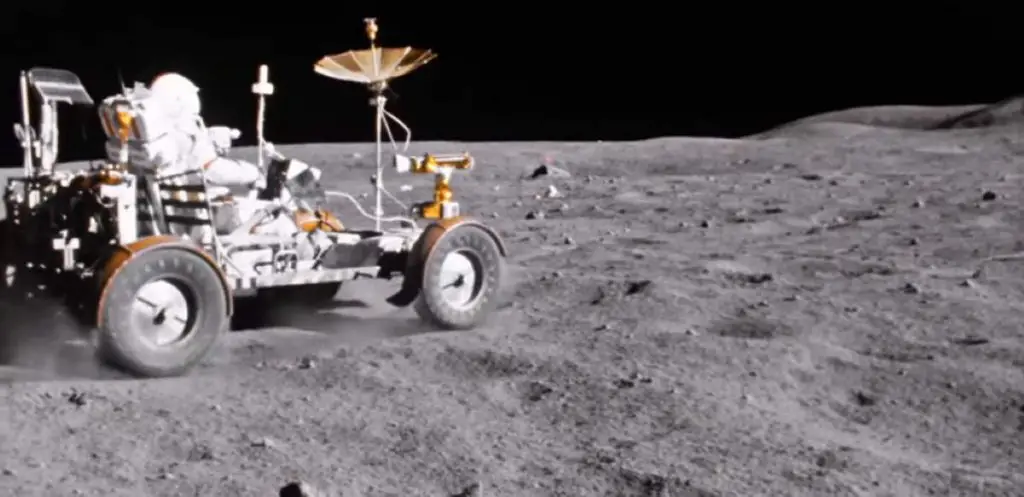Run by a Dutch restoration specialist who remastering historic videos using Artificial Intelligence (AI), the Dutch Steam Machine (Dutchsteammachine) channel has published remastered Apollo Moon landing videos, as well as some other vintage space videos, and the results are astonishing.

In NASA’s moon landing videos (as well as other vintage space videos like Gemini missions), the film restorer behind Dutch Steam Machine, who also goes by “Niels,” used Artificial Intelligence (AI) to stabilize blurry footage and create new frames; raising the frame rate (the number of frames that play per second), smoothed the motion, and made them look more like high definition (HD) videos.
For example, in the original NASA footage, the Apollo 16 Lunar Rover video “Grand Prix” looked like below (note that it is very shaky):
And the remastered version of the Apollo 16 Lunar Rover “Grand Prix” video is below:
Vintage space and Moon landing videos remastered – playlist
Here is the complete playlist of the vintage space and Moon landing videos remastered by the Dutch’s Team Machine channel.
Apollo Program
Also known as Project Apollo, The Apollo Program was the third United States human spaceflight program after Project Mercury (1958-1963) and Project Gemini (1965-1966).
It was carried out by the National Aeronautics and Space Administration (NASA) between 1961 and 1972, which succeeded in landing the first humans on the Moon from 1969 to 1972.
Apollo Program in a nutshell
- Duration: 1961-1972
- First flight: SA-1, October 27, 1961
- First crewed flight: Apollo 7, October 11, 1968
- Last flight: Apollo 17, December 19, 1972
- First Moon orbit: Apollo 8 (December 21-27, 1968)
- Successes: 32
- Failures: 2 (Apollo 1 and Apollo 13)
- Partial failures: 1 (Apollo 6)
- Successful crewed Moon landings: 6 times – Apollo 11, Apollo 12, Apollo 14, Apollo 15, Apollo 16, and Apollo 17
NASA’s Apollo program set several major human spaceflight milestones. It stands alone in sending crewed missions beyond low Earth orbit (see notes 1). Apollo 8 was the first crewed spacecraft to orbit another celestial body. Apollo 8 crew also witnessed the first Earthrise in history. Apollo 11 was the first crewed spacecraft to land humans on one.
Overall the Apollo program returned 842 pounds (382 kg) of lunar rocks and soil to Earth, greatly contributing to the understanding of the Moon’s composition and geological history.
The program laid the foundation for NASA’s subsequent human spaceflight capability and funded the construction of its Johnson Space Center and Kennedy Space Center. Apollo also spurred advances in many areas of technology incidental to rocketry and human spaceflight, including avionics, telecommunications, and computers.
Notes
- A low Earth orbit (LEO) is, as the name suggests, an orbit that is relatively close to Earth’s surface. It is normally at an altitude of less than 1000 kilometers (620 miles) but could be as low as 160 kilometers (100 miles) above Earth – which is low compared to other orbits, but still very far above Earth’s surface. For example, the International Space Station (ISS) orbits Earth in the Low Earth Orbit at an average altitude of 405 kilometers (250 miles).
Sources
- Apollo program on Wikipedia
- “Astonishing AI restoration brings Apollo moon landing films up to speed” on Live Science
- Low Earth Orbit on the European Space Agency (ESA) website
- Moon Landings: All-Time List [1966-2025] - February 2, 2025
- What Is Max-Q and Why Is It Important During Rocket Launches? - January 16, 2025
- Top 10 Tallest Rockets Ever Launched [2025 Update] - January 16, 2025



